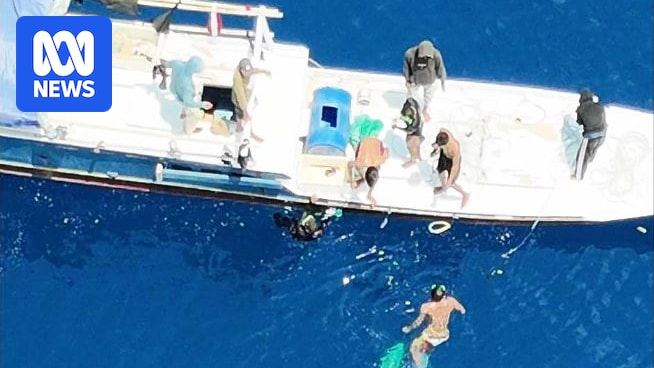A man who saw illegal fishing vessels while sailing along Western Australia’s north coast earlier this month says authorities failed to send a patrol vessel after he reported the sighting.
Lyndon Krollig said he had been sailing around Scott Reef in his catamaran for two-and-a-half weeks when he spotted at least five motorised fishing boats and “eight to 10” fishing sailboats in the vicinity.
Scott Reef, which is more than 300 kilometres off the Kimberley coast, sits within the “MoU box” — an area on the Timor Sea where Indonesian traditional fishers are permitted to operate provided they use traditional methods.
They are not permitted to use motorised vessels.
Despite the Australian Border Force saying it had ramped up its resources, Mr Krollig said he was told that there was no patrol vessel available to intercept illegal boats.
“Of course I was a little bit disappointed,” he said.
“To me it was a bit of an eye-opener and quite frustrating to see so many boats there.”
Lyndon Krollig said he was shocked to encounter illegal fishing vessels at Scott Reef. (Supplied: Lyndon Krollig)
Claims authorities lacked resources
Australian Border Force earlier this year said it had ramped up its patrols and resources after a surge in illegal fishing vessels was detected in northern Australia.
Loading…
On Tuesday, a border force spokesperson said officers had intercepted seven illegal foreign fishing vessels with a total of 51 crew in waters off the Western Australian and Northern Territory coastlines last week, with five of those boats found off the Kimberley coast.
Mr Krollig said while he had seen a surge in patrols while sailing along WA’s coast, he was shocked by the discovery.
“I’ve encountered many patrol boats who have asked me of illegal fishing boats coming to our waters, but I hadn’t encountered them until I got to Scott Reef,” he said.
“It actually shocked me to see so many.
“During the night, on the dead calm nights, you could actually hear them motoring around … quite a few of them.”
Australian Border Force has repeatedly encouraged members of the public to report any sightings to authorities.
Mr Krollig said he reported a sighting to border force on October 10 but he said he was told they were unable to send a patrol boat to the vicinity to apprehend the vessel.
Lyndon Krollig says he saw five illegal fishing boats at Scott Reef earlier this month. (Supplied: Lyndon Krollig)
“They did fly a plane out that night, had a look around but at that stage they said they had boats at Ashmore Reef and several boats along the coast, but they had nothing around the Scott Reef area to patrol,” he said.
“When they flew the plane overhead, they certainly located them, but locating them and catching them are two different things.”
Australian Border Force has grappled with a spike in illegal fishing off the north-west coast. (Supplied: Lyndon Krollig)
Concerns of concealed motors
Indonesia and Australia entered into an agreement in 1974 providing traditional Indonesian fishers access to an area within Australia’s waters to recognise the country’s long history of fishing in the area.
Under the agreement, fishing is restricted to traditional methods and boats that do not use motors or engines.
Mr Krollig said while he had seen multiple fishing sail boats in the region, he was concerned some appeared to be concealing motors.
“Under the guise of protection there was quite a few Indonesian boats with sails on them … but the majority of those boats still have a motor on them and tick along,” he said.
Mr Krollig said while he acknowledged the cost and difficulty of having authorities stationed in the area, he would like to see it happen for at least a couple of months.
“I do think these months is the most favourable weather times to travel down to these parts,” he said.
“Maybe over those few months they should put someone there and keep them under control.”
Australian Border Force did not comment on whether the vessels were intercepted but in a statement to the ABC, a spokesperson said it “continues to employ a range of enforcement options to detect and deter illegal foreign fishing in Australian waters”.
“The community can be assured every report of suspected illegal fishing is taken seriously,” they said.
